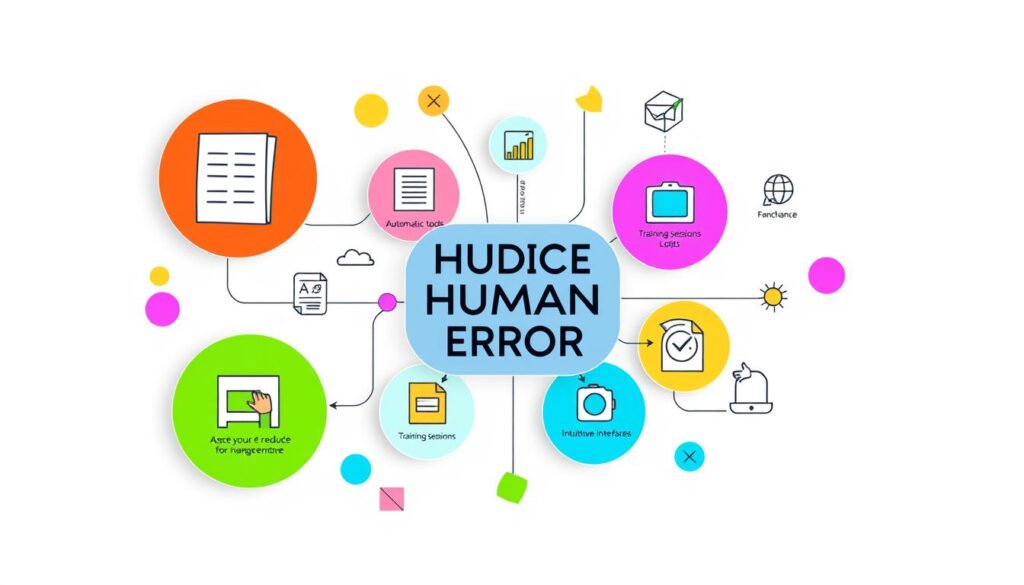Human error is a big challenge in achieving excellent operations and cybersecurity. In 2023, a 43% of individuals admitted to making mistakes at work affecting cybersecurity. Moreover, data breaches due to human error cost a lot, with an average of $3.33 million in losses. It’s crucial for businesses to understand errors happen from both actions and thoughts. They must work on human error reduction strategies to protect their operations and data.
Stress and heavy workloads play a big role in causing mistakes. 52% of people said stress led to errors, while heavy workloads affected 54% and 50% of workers. To minimize human errors, we must do more than just know about them. We need to use concrete error mitigation methods. This means using technology like automation and AI, doing root cause analysis, and building a safety and improvement culture. This approach helps fix errors and stop them before they happen.
Key Takeaways:
- Understanding that human error can significantly impact cybersecurity and overall business performance.
- Root cause analysis and technological solutions like AI are key in developing effective human error reduction strategies.
- The financial implications of human errors underscore the importance of implementing robust error mitigation methods.
- Addressing factors contributing to human error, such as workplace stress and system design, is critical to minimize errors.
- A culture of safety, continuous learning, and the use of automation technologies are vital in reducing human error frequencies.
- Emphasizing the need for regular training and process evaluations to maintain a high standard of operations.
Understanding Human Error in the Workplace
Mistakes made by people at work can lead to big problems. They happen when workers stray from their tasks or rules. Knowing about these mistakes and their impacts is key to stopping them.
Definition and Types of Human Error
Human error means not getting the expected result, even when trying our best. James Reason, a famous psychologist, said errors come from mental or physical plans that don’t work out. There are two big categories:
- Active failures: These are mistakes made during work, like not paying attention, that can cause big issues right away.
- Latent conditions: These are hidden flaws that can cause problems later due to poor decisions at different levels of the company.
Factors Contributing to Human Error
We have to understand why mistakes happen to stop them. Some common reasons include:
- Lack of Training: Not knowing enough or lacking skills can lead to errors.
- Inadequate Resources: Without the right tools or info, it’s easier to mess up.
- Poor Work Environment: Bad conditions can make it hard to think and perform well.
- Psychological Stress: Too much stress can cause bad decisions, leading to more mistakes.
The Impact of Human Error on Organizations
Mistakes can really hurt a company. They can lose money, harm their image, and even put people in danger. Mistakes can cause:
- Big financial losses, like in banking or healthcare.
- Harm to reputation, making customers leave and scaring away new business.
- Risks to safety, especially in fields like manufacturing, flying, and health.
By looking into these issues and using good ways to prevent errors, companies can be safer and more trustworthy. It’s important to keep getting better and learning from mistakes. This helps reduce errors a lot.
Importance of Reducing Human Error
It’s vital to reduce human error to enhance safety and compliance in organizations. This also boosts efficiency and productivity. By lowering errors, companies can save costs and prevent big failures. Keeping operations going and protecting a company’s image matters a lot.
Enhancing Safety and Compliance
Human errors lead to many accidents and exposure to dangers. Major accidents like Texas City and Chernobyl had human errors as a key factor. By learning from these mistakes, organizations can improve safety and follow rules better.
This helps avoid legal issues and fines associated with safety failures. With preventive tips and understanding errors, safety and rule-following get better.
Improving Efficiency and Productivity
Human errors slow down a company’s work and make it less reliable. About 23% of downtime in production comes from human mistakes. By checking processes carefully, companies work better and spend less.
This approach helps employees do better and cuts down costs. Making things run smoothly is key for a successful business.
Cost Implications of Human Error
Human errors have big costs, affecting a company’s spending and stability over time. In healthcare, mistakes lead to 4–17% of US hospital visits. These errors often can be stopped, saving a lot of money each year.
Mistakes can bring big problems, like what happened to Citigroup with a huge payment error. Using smart ways to spot and stop errors before they happen is crucial, especially in finance. This proactive way saves money and avoids problems.

When companies focus on preventing errors, they avoid big financial losses. They use smart tools to find where errors might happen. Learning from mistakes helps companies prepare better for the future.
Best Practices for Reducing Human Error
Reducing human error is key in any organization that wants to do better and be safer. There are several important ways to cut down on mistakes.
Implementing Standard Operating Procedures
Standard Operating Procedures (SOPs) ensure everyone does things the same way. They help lower mistakes, especially as a company grows. A big mistake at Citigroup, where an employee sent out $900 million by accident, could have been prevented with stricter SOPs. For more on improving operations with SOPs, check this comprehensive guide.
Utilizing Checklists and Reminders
Checklists and reminders make sure nothing is forgotten in complex tasks. They are very useful in healthcare, saving both money and lives. Using these tools digitally can also cut down on mistakes and improve how well rules are followed.
Encouraging a Safety-First Culture
Prioritizing safety leads to great benefits over time. In healthcare and other fields, this focus on wellbeing reduces risks. A culture of safety helps prevent expensive errors caused by human mistakes.
| Error Type | Prevention Strategy | Impact Example |
|---|---|---|
| Cybersecurity Breaches | Regular Training & MFA Implementation | Reduces risk from 60% to 10% in one year |
| Payment Errors | Automated Audit Trails | Prevented a $900M erroneous payment at Citigroup |
| Compliance Failures | Incident Response Planning | Significantly reduces negative outcomes by enhancing preparedness |
By using these error prevention techniques, organizations can create a safer, more reliable place to work. They also guard against big financial losses and damage to their reputation. Using these best practices to cut human error risks is crucial.
The Role of Technology in Minimizing Human Error
Today, using technology is crucial for preventing human mistakes. It helps automate tasks and increase accuracy. This is key in solving human error issues across industries.
Automation of Repetitive Tasks
By taking over repetitive duties, automation greatly reduces human errors. Hawkins Technologies saw less spam in protected emails thanks to automated security. This not only keeps data safe but also cuts down on the need for constant checking. It helps avoid mistakes due to overlooking details.
Error-Reduction Software Tools
Acronis found that using automation in cyber defense lowers downtime and its big costs, especially after ransomware attacks. Tools like the Confidence Score in IDP systems make errors almost disappear. They move us from relying on people to trusting systems.
Data Analytics for Insightful Decision Making
Using data analytics helps avoid and fix issues leading to human errors. It helps spot mistake patterns and threats early, increasing accuracy. By using advanced analytics, we’ve seen an 85% drop in errors. This shows how powerful these tools are in everyday tasks.
| Statistic | Detail |
|---|---|
| Annual Cost of Poor Data Quality (2021) | $12.9 million |
| Percentage of Data Breaches Due to Mistakes | 85% |
| Reduction in Errors with Intelligent Automation | 85% |

New technologies are changing how we reduce human errors. They offer strong ways to enhance security and work better. By using these methods wisely, organizations avoid expensive mistakes and build stronger operations.
Training and Development Programs
Effective training programs are key to reducing human errors in the workplace. They provide learning chances that improve an employee’s skills and introduce new error prevention methods within companies. By focusing on specific job roles, these programs can cut down on mistakes and raise efficiency.
Importance of Continuous Learning
The fast pace of today’s industries means workers need to constantly update their knowledge and skills. Continuous learning is essential for keeping staff skilled and ready, especially when facing quick changes in technology and regulations. It plays a big part in improving quality control, cutting down on errors, and boosting safety at work.
Effective Training Techniques
Simulation training is a growing trend for giving workers a taste of real-life situations without the risks. It allows them to try out different scenarios and see possible results. This helps in making smarter choices and lowers mistakes in the real work setting. Besides, combining on-the-job training with digital courses creates a full learning experience that blends practical and conceptual knowledge.
Measuring Training Effectiveness
To really improve accuracy and reduce errors, it’s key to check how well training programs are working. Doing regular reviews and getting feedback helps trainers make their programs better fit the changing needs of employees. Looking at error rates, how efficient production is, and testing employee skills are good ways to see if training is successful.
| Training Technique | Benefits | Error Reduction Potential |
|---|---|---|
| Simulation-based Training | Safe, realistic practice environment | High |
| On-the-Job Training | Immediate application of skills | Medium |
| Digital Learning Platforms | Flexible, accessible learning | Medium |
| Structured Feedback | Continuous improvement | High |
Fostering a culture focused on continuous improvement and training can create a smarter workforce. This workforce can manage today’s complex work settings with fewer errors. Thus, it maintains high operational standards and keeps a competitive edge.
Evaluating and Refining Error Reduction Strategies
We must focus on evaluating and refining our safety measures to reduce human errors. In manufacturing, about 48.8% of errors come from stress and the work environment. This shows how crucial our mission is.
With 40% of U.S. workers reporting fatigue, the risk for errors goes up. These mistakes can cost a lot of money. They can also harm people and the reputation of a company.
Gathering Feedback from Employees
Listening to employees is key to stopping human errors. They know the problems in daily operations. Their feedback can show us how to prevent errors.
Workers can spot problems that managers might miss. This helps us find practical solutions. For instance, human error causes 23% of unplanned stops in manufacturing. Worker feedback is very valuable.
Conducting Regular Audits and Assessments
Conducting regular audits is a must to fight human error. Studies show that 90% of industrial accidents involve human mistakes. These errors can have huge costs and even cause deaths.
A thorough check can reveal hidden issues in our error prevention. This can help us avoid things like medication mistakes, a major cause of death in the U.S.
Adapting Strategies Based on Data and Trends
Adapting to errors requires a flexible approach. Using data and watching trends can help us prevent mistakes. For example, automation helps reduce errors in manufacturing.
An organization’s strategy to prevent errors must be based on data. Understanding the effects and costs of errors is crucial. This could include huge losses or even loss of life. Looking into ways to improve business processes can be a big part of preventing errors.
FAQ
What are effective human error reduction strategies?
To reduce human errors, we use several strategies. These include making Standard Operating Procedures (SOPs), creating checklists, and putting reminders in place. We also automate tasks that are done over and over again.
Deploying tools for reducing errors and doing root cause analyses help a lot. It’s also key to keep learning and developing. These methods make tasks clearer, help us rely less on memory, and make better decisions.
How can we understand human error in the workplace?
Understanding human error at work means knowing the kinds of mistakes that can happen. These could be in action or thought. We look into what causes these errors, like stress, being tired, doing many things at once, or not being trained right.
Human errors can have big impacts, leading to lost money, damage to reputation, and safety risks.
Why is reducing human error important?
It’s vital to cut down on human errors to keep everyone safe and follow regulations. This also boosts how well and how much we produce.
Preventing errors saves a lot of money tied to mistakes. It’s a major part of managing risks to keep a company’s good name and money safe.
What role does technology play in minimizing human error?
Technology helps a lot in reducing human errors. It does this by doing repeatable tasks for us, which cuts down on simple slip-ups.
Tools that help reduce errors and looking at data closely offer new insights. These help us avoid mistakes and make smarter choices beforehand.
How do training and development programs help reduce human error?
Programs for training and growing are key in making fewer mistakes. They give people the know-how and skills to do their jobs right.
Having a culture of ongoing learning helps us adapt and see mistakes as chances to get better. This way, everyone can do their work more accurately and confidently.
How can organizations evaluate and refine their error reduction strategies?
For better error-reduction methods, organizations listen to what employees say and get feedback. They do audits and check where they can get better regularly.
They then change their strategies based on what they find out and what’s new. This way, they make sure their ways of stopping errors stay helpful and up-to-date.



